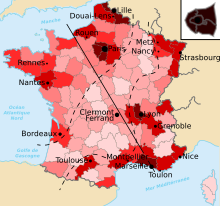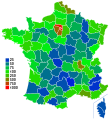Diagonal du vide
The Diagonale du vide (German: Empty Diagonale) describes a geographic situation in France . Between the Landes department in the southwest and Meuse in the northeast, the population density is very low in contrast to the rest of France.
description
The low population density (less than 30 inhabitants / km²) in the area is primarily a result of rural exodus and urbanization in the 19th and 20th centuries. Some commentators prefer to speak of the diagonale des faibles densités (diagonal of the low density) and consider the term diagonale du vide to be derogatory. Nevertheless, the DATAR (Interministerial Delegation for Regional Planning and Regional Attractiveness), which existed until 2014, used the term.
The phenomenon is easier to see at the departmental level than at the regional level . The thin settlement continues in Spain and Portugal .
History and Development
Before the Diagonale du vide was created, the Saint-Malo - Geneva line separated the industrial north-east from the areas in the south-west, which were more dominated by agriculture. Charles Dupin identified this in his 1837 treatise Forces productives et commerciales de la France .
In 1846 the rural population in France declined. While 43.8% lived from agriculture in 1906, it was 31% in 1951 and 1.4% in 2012. This process was particularly noticeable in the mountainous regions of southern France with their heavy stony soils. In the Ardèche department , the population decreased from 388,500 inhabitants (1861) to 245,600 in 1962.
In 1947 the geographer Jean-François Gravier wrote about the French desert, which more or less corresponded to the modern concept of the diagonale du vide.
Hervé Le Bras and Emmanuel Todd argue that the growth of the department like Indre and Gers makes the concept obsolete. In their opinion, the area of negative population growth only extends from the Massif Central to Lorraine . However, an analysis at the cantonal and municipal level reveals that the area is larger and that the growth observed by Le Bras and Todd is mainly based on the influx of pensioners and is therefore very fragile.
literature
La Diagonale du vide is the title of a novel by Pierre Péju from 2009. In it, a businessman from the city seeks rest in a cottage in Ardèche .
Between 2015 and 2016, the author and blogger Mathieu Mouillet explored the Diagonale du vide for 18 months . He reported on his experiences on his blog.
gallery
Individual evidence
- ↑ Jean-Claude Bontron (1976). La France des faibles densités, II: Documentation bibliographique, Analyzes d'études. SEGESA ACEAR.
- ↑ Gilles Fumey: La France en diagonales (PDF) October 26, 2009. Accessed July 18, 2016.
- ↑ Le Massif Central: au coeur de la diagonale du vide .
- ↑ La France: des territoires en mutation .
- ↑ Rozenblat, C .: Tissu d'un semi de villes européennes .
- ↑ Yoann Doignon, Sébastien Oliveau, Isabelle Blöss-Widmer: L'Europe méridionale depuis 20 ans: dépeuplement, dépopulation et renouveau démographique .
- ↑ Deprise - Géoconfluences. Retrieved July 9, 2020 (French).
- ^ La France et ses territoires / coordination: Luc Brière, Suvani Vugdalic. - Institut national de la statistique et des études économiques, 2015. P. 95 P. 172
- ↑ Armand Frémont. La terre // Les Lieux de mémoire / Dir. Pierre Nora. - Quarto Gallimard, 1997. pp. 3050-3051.
- ^ Hervé Le Bras, Emmanuel Todd, Le Mystère français , seuil, 2013
- ↑ Yoann Doignon, Sébastien Oliveau: Is the French diagonally emptying? An exploratory spatial analysis of demographic decrease in France for the past 50 years . 20th January 2016.
- ↑ Yoann Doignon, Sébastien Oliveau, Isabelle Blöss-Widmer: L'Europe méridionale depuis 20 ans: dépeuplement, dépopulation et renouveau démographique . In: Espace populations sociétés. Space populations societies . No. 2015 / 3-2016 / 1 , March 20, 2016, ISSN 0755-7809 , doi : 10.4000 / eps.6171 ( openedition.org [accessed on July 9, 2020]).
- ↑ Peju, Pierre, 1946-: La du diagonal vide: roman . Gallimard, [Paris] 2009, ISBN 978-2-07-078103-4 .
- ↑ La diagonale du vide .



